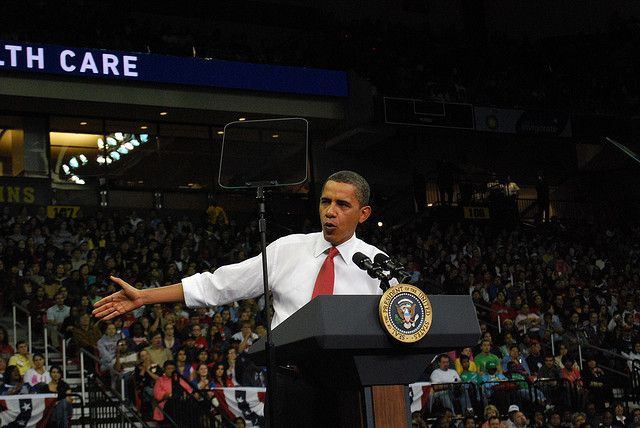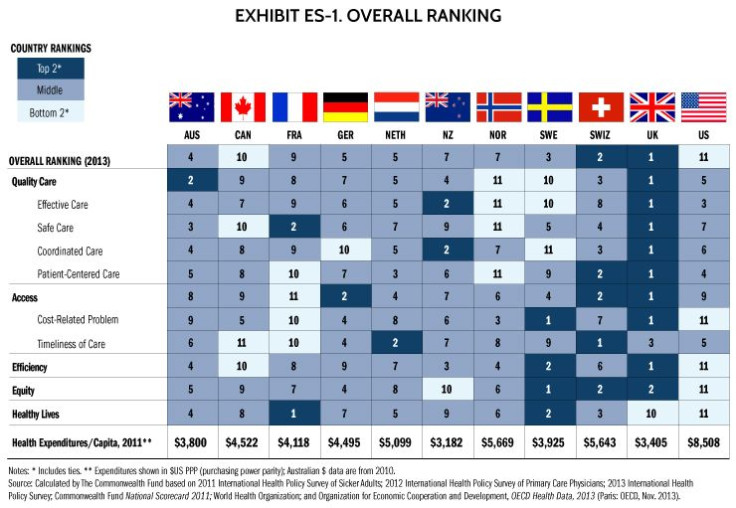US Health Care Ranks Dead Last In Contest With 10 Other Countries; Efficiency And Equity Perform Worst

By now, it is a lame and mostly obvious statement that America’s health care system doesn’t stand up well to those in other countries. However, the reinforcement never hurts. A new analysis of 11 of the top countries around the world shows the U.S. ranks dead last when it comes to keeping its people healthy.
The new report, released as part of the Commonwealth Fund’s annual survey of the world’s top (and bottom) health care systems, shows that while the United States performs ably in measures of effective care and patient-centered care, it’s downright lousy in just about everything else. This is important, because it means the nation that far and away spends the most money per capita on health care isn’t offering or receiving the best.
Money isn’t the problem in the U.S. — not the absence of it, at least. The U.S. spent more money per person than any of the other 10 nations in 2011, at $8,508 per capita. New Zealand, the country whose citizens spent the least, felt an average burden of $3,182. But the survey’s shining star was the United Kingdom. Out of 11 total rankings, the U.K. secured eight of the number one spots. The remaining three scores fell at 2, 3, and 10. (The U.K. and U.S. fell at 10 and 11, respectively, in the measure of Healthy Lives, which records mortality related to medical care — such as infant mortality and longevity past age 60.)

The report divided a country’s health care into five categories: Quality, Access, Efficiency, Equity, and Healthy Lives. Quality reflects the care itself — how well it gets sick people better. Access reflects how many people can get that care. Efficiency reflects how long that care takes, both to get initially and to complete. Equity reflects the proportion of people who can get care relative to other people. And Healthy Lives reflects how well the care holds up over time. (If Quality were the weather, Healthy Lives would be the climate.)
Unsurprisingly, the U.S. ranks last on many of these measures; equity, efficiency, and healthy living being the most outstanding. Low-income Americans face massive, often insurmountable, obstacles compared to even middle-class citizens, whose employers typically supply employees’ health insurance plans. In the report, Access is broken down into two sub-categories: Cost-related Problem and Timeliness of Care. Though fifth in timeliness, the U.S. placed 11th in problems related to cost, owing to the vast gulf between income brackets.
One thing the report can’t explain is the relative success or failure of individual states. California’s population is nearly four times larger than Switzerland’s, for example, which means that within each state exists greater potential for variability than among certain countries. In other words, it may be the case that America’s individual states are more volatile, contributing to a poor average score, even if certain states perform well on their own.
Admittedly, the Affordable Care Act has made genuine attempts to bridge the income-spurred health insurance gap, in particular with its online marketplaces, by introducing greater flexibility and choice into the system. Many people, however, see the move as little more than a bone thrown to the American public, who desperately need their health care moved to a universal system. This system, by no accident, is found in many of the top countries in the recent report.
Other factors also play an important role. These include highly inflated doctors’ salaries, the exorbitant costs of medicines and procedures, and massive, stalwart insurance companies that aren’t forced to compete for the lowest prices. Before those infrastructural changes can be made, in the meantime doctors must prioritize care on an individual level, the report states.
“Significant incentives now encourage U.S. providers to utilize integrated medical records and information systems that are accessible to providers and patients,” it reads. “Those efforts will likely help clinicians deliver more effective and efficient care.”



























